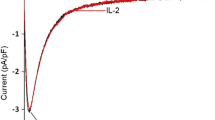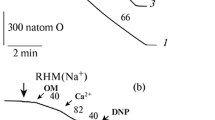Summary
The mechanism of spontaneous diastolic depolarizations induced by different Ca2+ overloading conditions (ouabain toxicity, calcium ionophore A23187, O-K, high Ca2+ solution) in mammalian working myocardium fibres was studied with conventional microelectrode technique and pharmacological approach.
Antagonistic properties of antiphospholipase-A2 (PL A2)-active compounds (dexamethasone and indomethacin) were tested. Membrane oscillation in Ca2+ overload conditions were shown to be eliminated or largely protected by both anti-inflammatory agents. There was no influence of the compounds on electrical parameters and ion currents in intact mammalian and amphibian myocardium. The data obtained suggested that modulation of Ca2+-dependent PL A2 activity may contribute significantly to membrane destabilization due to Ca2+ overload of cardiac cells. An analogous membrane destabilizing action of exogenous PL A2 observed in Langendorff-perfused guinea pig heart is in favour of the hypothesis introduced.
Similar content being viewed by others

References
Beckman JK, Owens K, Knauer TE, Weglicki WW (1982) Hydrolysis of sarcolemma by lysosomal lipases and inhibition by chlorpromazine. Am J Physiol 242:H652-H656
Bhattacharyya ML, Vassalle M (1981) The effect of local anesthetics on strophanthidin toxicity in canine cardiac Purkinje fibres. J Physiol 312:125–142
Blackwell GJ et al (1982) Glucocorticoids induce the formation and release of anti-inflammatory and anti-phospholipase proteins into the peritoneal cavity of the rat. Br J Pharmac 76:185–194
Bolli R (1982) Protection of ischemic myocardium in experimental animals and in man: a review. Cardiovasc Res Center Bul 21:1–33
Brown BS (1982) Early afterdepolarization induced by batrachotoxin: possible involvement of a sodium current. Fed Proc 42:581
Chien KR, Reeves JP, Buja M, Bonle F, Parkey R, Willerson JT (1981) Phospholipid alteration in canine ischemic myocardium. Circ Res 48: 711–719
Cheung WY (1980) Calmodulin plays a pivotal role in cellular regulation. Science 207:19–27
Brum G, Flockerzi, Hoffman F, Osterrieder W, Trautwein W (1983) Injection of catalytic subunit of cAMP-dependent protein kinase into isolated cardiac myocytes. Pflügers Arch 398:147–154
Clusin WT, Bristow MR, Karagueuzian HS, Katzung BG, Schroeder JS (1982) Do calcium-dependent ionic currents mediate ischemic ventricular fibrillation? Am J Cardiol 49:606–611
Cranefield PF (1977) Action potentials, afterpotentials and arrhythmias. Circ Res 41:415–423
Eisner DA, Lederer WJ (1979) Inotropic and arrhythmogenic effect of potassium-depleted solutions on mammalian cardiac muscle. J Physiol 294:255–277
Ferrier GR (1977) Digitalis arrhythmias: Role of oscillatory afterpotentials. Progress in cardiovascular diseases. 19:459–479
Filippov AK, Porotikov VI (1983) Hormonal regulation of calcium channels in cardiac membranes. Biofisika28:675–678
Filippov AK, Porotikov VI (1983) Voltage clamp analysis of repetitive firing in frog atrial trabeculae. Gen Physiol Biophys 12:95–106
Flower R (1978) Steroidal antiinflammatory drugs as inhibitors of phospholipase A2. Advances in Prostaglandin and Thromboxane Res, 3 (ed by Galli C et al.) Raven Press, New York, 105–112
Franson RC, Pang DC, Weglicki WB (1979) Modulation of lipolytic activity in isolated canine cardiac sarcolemma by isoproterenol and propranolol. Bioch Bioph Res Comm 90:956–962
Franson RC (1980) Inhibition of highly purified mammalian phospholipase A2 by non-steroidal anti-inflammatory agents. Bioch J 186:633–636
Heistracher P, Pillat B (1962) Elektrophysiologische Untersuchungen über die Wirkung von Chinidin auf die Aconitinvergiftung von Herzmuskelfasern. Naunyn-Schmiedeberg's Arch exp Path Pharm 244:48–62
Irvine RF (1982) How is the level of free arachidonic acid controlled in mammalian cells? Biochem J 204:3–16
Ito K, Kapaki H, Urakawa N (1979) Effects of palytoxin on mechanical and electrical activities of guinea pig papillary muscle. Jap J Pharmacol 29:467–476
Lederer WJ, Tsien RW (1976) Transient inward current underlying arrhythmogenic effect of cardiotonic steroids in Purkinje fibres. J Physiol 263:73–100
Kass KS, Tsien RW (1982) Fluctuations in membrane current driven by intracellular calcium in cardiac Purkinje fibers: Bioph J 381:259–269
Katz AM, Messineo FC (1981) Lipid-membrane interactions and the pathogenesis of ischemic damage in the myocardium. Circ Res 48:1–16
Kanazir DT, Stepic NR (1982) Extragenomic effect of glucocorticoids. Prog Clin Biol. Res 102:193–205
Kaplan L, Weiss J, Elsbash P (1978) Low concentrations of indomethacin inhibit phospholipase A2 of rabbit polymorphonuclear leukocytes. Proc Natl Acad Sci USA 75:2955–2958
Karagueuzian HS, Katzung BG (1981) Relative inotropic and arrhythmogenic effect of five cardiac steroids in ventricular myocardium: oscillatory afterpotentials and the role of endogenous catecholamines. J Pharmacol Exp Ther 218:348–356
Kretsinger RH (1981) Mechanisms of selective signalling by calcium. Neurosciences Research Program 217–327
Rosen MR, Danilo P, Alonso M, Pippenger CE (1976) Effect of therapeutic concentrations of diphenylhydantion on transmembrane potentials of normal and depressed Purkinje fibers. J Pharmac Exp Ther 197:594–604
Rosen M, Danilo P (1980) Effects of tetrodotoxin, lidocain, verapamil, and AHR-2666 on ouabain-induced delayed afterdepolarization in canine Purkinje fibers. Circ Res 46:117–124
Ruff RL, Stühmer W, Almers W (1982) Effect of glucocorticoid treatment on the excitability of rat skeletal muscle. Pflügers Arch 395:132–137
Rougier O, Vassort G, Stampfli R (1968) Voltage clamp experiments of frog atrial heart muscle fibres with the sucrose gap technique. Pflügers Arch 301:91–108
Saxon ME, Vorobiev SI, Beloyartsev FF, Baum OV (1981) The role of phospholipase A2 in cardiac arrhythmias. 8th International Congress of Electrocardiology. Budapest, Hungary, Abstracts p 41
Saxon ME, Vorobiev SI (1984) Triggered arrhythmias induced with exogenous phospholipase A2 in Langendorff perfused hearts and their pharmacological analysis. Basic Res Cardiol, in press
Saxon ME (1983) Efficiency of antiphospholipase A2 active compounds in stabilization of cardiac membrane under digitalis toxicity. 10th International Congress on Electrocardiology, Bratislava, Czechoslovakia, p 210
Schaffer SW, Burton KP, Jones HP, Oel HH (1983) Phenothiazine protection in calcium overload-induced heart failure: a possible role for calmodulin. Am J Physiol 244:H328-H334
Shier T (1982) Cytolytic mechanisms: self-destruction of mammalian cells by activation of endogenous hydrolytic enzymes. J Toxicol-Toxin, Reviews 1:1–32
Vanderhock JY, Feinstein MB (1979) Local anesthetics, chlorpromazine and propranolol inhibit stimulus activation of phospholipase A2 in human platelets. Mol Pharmacol 16:171–180
Wasserstrom JA, Ferrier GR (1982) Effects of phenytoin and quinidine on digitalis-induced oscillatory afterpotentials, aftercontractions and inotropy in canine ventricular tissues. J Mol Cell Cardiol 14:725–736
Wightman PD, Dahlgren ME, Bonney RJ (1982) Protein kinase activation of phospholipase A2 in sonicates of mouse peritoneal macrophages. J Biol Chem 257:6650–6652
Wong PY-K, Cheung WY (1979) Calmodulin stimulates human platelet phospholipase A2. Bioch Biophys Res Com 90:473–480
Author information
Authors and Affiliations
Rights and permissions
About this article
Cite this article
Saxon, M.E., Filippov, A.K. & Porotikov, U.I. The possible role of phospholipase A2 in cardiac membrane destabilization under calcium overload conditions. Basic Res Cardiol 79, 668–678 (1984). https://doi.org/10.1007/BF01908384
Received:
Issue Date:
DOI: https://doi.org/10.1007/BF01908384



